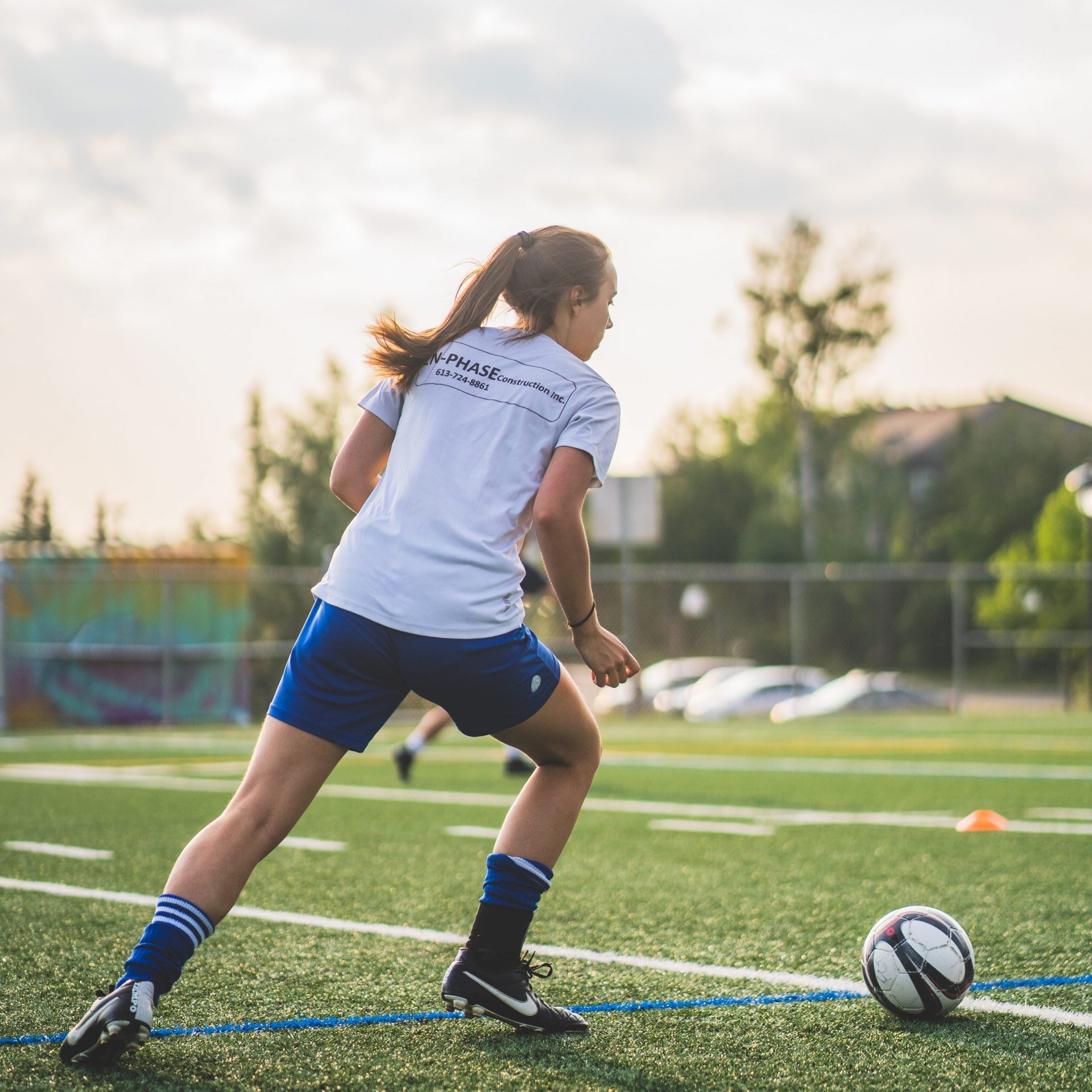Cruciate Ligament Rupture (ACL Tear) – Diagnosis, Surgical Methods, and Recovery Duration
Maybe it happened while you were skiing or playing soccer: One wrong move, a twist of the knee, and you think you might have torn your anterior cruciate ligament (ACL). Injuries to the ACL are all too common and can often be trivialized, especially when the symptoms don’t seem severe.
In fact, pain is not necessarily associated with a cruciate ligament tear, and the muscles around the knee are often able to stabilize the joint during normal movements such as walking or stepping onto something. Nevertheless, an injury of this kind should not be taken lightly. If left untreated, a cruciate ligament tear can lead to irreparable damage to the meniscus or joint cartilage.
In this article, Dr. Gäbler of the SPORTambulatorium Wien explains how an ACL tear is diagnosed,, when ACL surgery is necessary, and all about the different surgical methods .

Table of Contents
- How can cruciate ligament injury occur?
- Cruciate ligament tear: Diagnosis & Treatment Methods
- How is an ACL tear diagnosed?
- When does an ACL tear need surgery?
- How soon should ACL surgery take place?
- The ideal time for cruciate ligament surgery: 7–10 days after injury.
- Cruciate ligament tear: A rapid diagnosis is important
- How does cruciate ligament surgery work and what options are available?
- Rehabilitation – How long does it take to recover from a torn cruciate ligament?
- Injury and therapy of the posterior cruciate ligament
- Cruciate ligament tear in children
- Cruciate ligament injuries in the elderly
- Conclusion: A cruciate ligament tear always requires medical treatment!
More questions?
Our experts are happy to help you
Just give us a call!
How can cruciate ligament injury occur?
Injuries to the anterior cruciate ligament (ACL) are particularly common and can occur through hyperextension or in conjunction with an external rotation of the leg when the lower leg is stationary and flexion occurs simultaneously. A cruciate ligament tear often occurs while playing football, or when skiing, practicing martial arts, or inline skating.
Cruciate ligament tear: Diagnosis & Treatment Methods
How is an ACL tear diagnosed?
Diagnosis is made primarily through medical examination, but should always be confirmed using magnetic resonance imaging (MRI).
When does an ACL tear need surgery?
Although many amateur athletes—and all professional athletes—have strong muscles that are able to stabilize the knee joint well in the beginning, considerable strain occurs over time, especially when playing sports with rapid rotational movements or sudden stops.
Anybody who participates in “stop and go” sports such as football, volleyball, step aerobics, or tennis without a stable cruciate ligament can expect meniscus and cartilage degradation in the knee joint. Hiking, mountain climbing, and running should also be done only with an intact cruciate ligament.
One main difficulty that accompanies ACL tears is instability. Dr. Gäbler explains:
“Patients often feel like their knee keeps slipping away from them. The instability overloads the remaining knee joint stabilizers, often resulting in further injury and additional damage to the meniscus and cartilage. This is why I recommend that not only professional athletes, but really anybody who loves running, playing ball, skiing, or hiking undergo an operation if they have an ACL tear.”
How soon should ACL surgery take place?
Particularly for physically active patients, cruciate ligament surgery should take place as early as possible in order to reduce recovery time. Another advantage of early surgery is that common meniscus injuries can be simultaneously treated as well.
Patients are sometimes incorrectly told that a cruciate ligament tear must be operated on within 24 hours, otherwise they run the risk of serious knee problems.
However, this is not accurate and does not reflect the current state of medical research. If you ever feel pressured to undergo an operation immediately, Dr. Gäbler recommends that you promptly make an appointment with a doctor you trust.
The ideal time for cruciate ligament surgery: 7–10 days after injury.
Current research shows that it is possible to undergo cruciate ligament surgery up to 7–10 days after the injury. An operation within 24 hours is not usually necessary.
However, it is important to clarify the medical situation with an MRI as quickly as possible in order to stay within the tight time window, as knees can become inflamed after 10–14 days (and sometimes much earlier).
The SPORTambulatorium Wien is there for you when you need an appointment quickly. You can reach us by phone at 01 4021000.
Cruciate ligament tear: A rapid diagnosis is important
After 10–14 days (and sometimes much earlier), an inflammatory reaction occurs in the knee joint, causing increased swelling, inflammation, and reduced mobility of the knee.
An operation is no longer feasible at this stage, as there is a high risk of postoperative mobility restriction, or arthrofibrosis.
Your surgeon can use arthroscopy to determine if your knee is too inflamed to operate, in which case reconstructive surgery can be performed at a later date. This can sometimes mean a waiting period of 6–8 weeks before surgery.
However, in some cases it may be recommended to undergo knee surgery during the period when ACL replacement surgery is not possible—for example, when the ACL is severed at the bone and can be sutured again (see below: cruciate ligament suture (reinsertion or refixation)) or if an MRI shows a meniscal tear in addition to the ACL injury. In such an instance, the meniscus is sutured in an initial operation, and the ACL is reconstructed once the inflammation has subsided.
The surgical possibilities must always be evaluated in a detailed discussion and must take into consideration the patient’s athletic goals, physical strain at work, and age.
How does cruciate ligament surgery work and what options are available?
Preserving the ACL
Our primary goal is always to retain the ACL whenever possible. However, this is only a possibility in the 10–20% of cases in which the ACL is torn at the very top of its anchoring point and blood flow to the ACL has thus not been interrupted. This is more common with children and adolescents than with adults. In such cases, the ACL can be reattached with a type of dowel pin (reinsertion) and can then heal and reattach. See below for more information about cruciate ligament reinsertion and refixation.
Reconstructing the ACL
In most cases, the cruciate ligament is irreversibly damaged and must be replaced with an endogenous tendon during surgery.
Als Ersatzsehne werden entweder zwei Kniebeugersehnen (STG) verwendet, die Quadriceps tendon, oder Allografts (Spendersehnen).
Which tendon will be used to replace the cruciate ligament depends on several factors which are discussed with the patient ahead of time in great detail.
For detailed information on the different methods and their advantages and disadvantages, we recommend the following article: Cruciate Ligament Surgery – Indications, Methods, and Success Rates
Rehabilitation – How long does it take to recover from a torn cruciate ligament?
The good news: More than 90% of patients recover full functionality, mobility, and strength following cruciate ligament replacement surgery.
However, the cruciate ligament also has receptors that are continually sending information to the brain about how the body is positioned in space (proprioception), which activates different muscle groups. The loss of these receptors causes a deterioration of fine motor skills and coordination and often leaves patients with an unfamiliar feeling for months.
One of Dr. Gäbler’s patients expressed it like this: “It’s like the knee doesn’t belong to me yet; it suddenly feels completely different.”
It’s important to know that 50% of the operation’s success depends on the subsequent rehabilitation and physiotherapy. Only in conjunction with professional postoperative therapy can full mobility, muscle strength, and coordination be regained.
Depending on how consistent patients are with their coordination exercises (e.g., using the MFT balance board), the unfamiliar feeling in the knee usually disappears within 6–24 months as new receptors are formed.
Injury and therapy of the posterior cruciate ligament
Injuries to the posterior cruciate ligament occur primarily in conjunction with a violent impact, such as in a car accident or during some ball sports (American football, handball, etc.).
These injuries are much less common than ACL tears and can be healed surgically or, in many cases, without surgery. The decision to operate depends on the degree of instability, the symptoms, and above all the patient’s athletic requirements.
Wenn das Knie massiv instabil ist (oder trotz konservativer Therapie instabil geblieben ist), ist die OP definitiv erforderlich, da sonst sehr rasch mit einer Arthrose des Kniegelenks zu rechnen ist
Da es bei frischen Verletzungen immer zu massiven Zerreißungen der Gelenkskapsel kommt, ist die sofortige OP des hinteren Kreuzbandes nicht indiziert. Es wird primär mit Ruhigstellung und speziellen PCL-Orthesen gearbeitet, da das hintere Kreuzband (im Gegensatz zum vorderen) eine gute Heilungschance auch ohne OP hat. Bei chronischen Fällen bzw anhaltender Instabilität des hinteren Kreuzbandes empfiehlt Univ. Prof. Dr. Christian Gäbler Spendertransplantate (Allografts), da man für das hintere Kreuzband extrem kräftige Bandstrukturen benötigt.
Cruciate ligament tear in children
Cruciate ligament injuries in children are much more uncommon than in adults and, unfortunately, are often overlooked. An MRI is necessary in all cases, and if symptoms persist it is important to consult a specialist.
If the child’s knee is not too unstable (e.g. partial tears in the anterior ligament), it is first immobilized using a splint to provide an opportunity to heal and physiotherapy to begin as soon as possible. A follow-up exam is carried out 6 to 8 weeks after the injury to determine whether the ligament needs to be operated on or not.
If the knee joint is unstable, early surgery is recommended, as children’s high activity level often causes additional injuries of the menisci and the cartilage , thus initiating the path to rapid and early deterioration of the knee. With an early operation, a successful ACL suture or reinsertion is often possible, particularly for children, and the sooner surgery is performed the higher the chances of success. Alternatively, a cruciate ligament replacement (all-inside) must be performed.
Many studies clearly show that cruciate ligament surgery is very important in the case of unstable knee joints, especially in children and adolescents—three recent studies are listed below pars pro toto (scroll down for links):
1) One study published in the Orthopaedic Journal of Sports Medicine in 2021 showed that when an ACL rupture has not been operated on, the probability of a meniscus rupture increases by 16–20% with each year. Every 2-point increase in BMI raises the risk of a medial meniscal tear by 10% and a lateral meniscal tear by 12%.
2) A 2021 meta-analysis published in the American Journal of Sports Medicine showed that delaying pediatric cruciate ligament surgery by more than 12 weeks significantly increased the risk of meniscal injuries and irreparable meniscal tears.
3) Another meta-analysis from 2018 with around 1,500 children and adolescents showed that early ACL reconstruction significantly reduced the risk of meniscal ruptures and secondary cartilage damage.
Cruciate ligament injuries in the elderly
Cruciate ligament injuries in the elderly do not require surgery when the level of activity is low. In such cases, the primary therapy is immobilization and muscle strengthening (physical therapy). We often see that old untreated cruciate ligament injuries have caused damage (arthrosis) that can prove problematic.
For athletic and active seniors who want to be out in the mountains or playing tennis with a stable knee joint, surgery is recommended. The chosen method (STG vs. plastic band) should be discussed and determined on a case-by-case basis.
Conclusion: A cruciate ligament tear always requires medical treatment!
An injury of this kind should never be taken lightly. If left untreated, a cruciate ligament tear can lead to irreparable damage to the meniscus or joint cartilage. In case of accidents or injuries to the knee – with or without pain – an appointment with a specialist is always necessary.
The knee specialists at the SPORTambulatorium Wien – Center for Orthopedics and Sports Traumatology, under the guidance of highly experienced knee surgeon Dr. Christian Gäbler, provide expert and personalized care of knee ligament injuries using the most modern arthroscopic surgical methods, as well as non-surgical treatment whenever possible.
Related information about cruciate ligament tears:
- Karolinska Institute, Stockholm: No risk of arthrofibrosis after acute anterior cruciate ligament reconstruction (Knee Surgery Sports Traumatol Arthrosc. 2018)
- Interview with Dr. Gäbler in the Kurier (in German): Kreuzbandriss – Knieschmerz nie verniedlichen, Dezember 2010
More questions?
Our experts are happy to help you
Just give us a call!
Quellen & Abstracts
1) Orthop J Sports Med . 2021 Mar 15;9(3):
Rates of Concomitant Meniscal Tears in Pediatric Patients With Anterior Cruciate Ligament Injuries Increase With Age and Body Mass Index
Crystal A Perkins et al.
Abstract
Background: Anterior cruciate ligament (ACL) tears are frequently associated with meniscal injury. Risk factors for concomitant meniscal injuries have been studied in the adult population but less so in pediatric patients.
Purpose: To evaluate the relationship between age and body mass index (BMI) and the presence of a concomitant meniscal tear at the time of ACL reconstruction (ACLR) in pediatric patients.
Study design: Case-control study; Level of evidence, 3.
Methods: A single-institution retrospective review was performed of patients aged <19 years who underwent primary ACLR over a 3.5-year period. Revision ACLR and multiligament knee reconstructions were excluded. Logistic regression was used to identify risk factors associated with having a meniscal tear at the time of surgery. Subgroup analysis was performed for medial and lateral meniscal tears.
Results: Included in this study were 453 patients (230 males, 223 females; median age, 15 years). Of these, 265 patients (58%) had a meniscal tear, including 150 isolated lateral meniscal tears, 53 isolated medial meniscal tears, and 62 patients with both lateral and medial meniscal tears. Median time from injury to surgery was 48 days. For every 1-year increase in age, there was a 16% increase in the adjusted odds of having any meniscal tear (odds ratio [OR], 1.16; 95% confidence interval [CI], 1.05-1.27; P = .002), with a 20% increase in the odds of having a medial meniscal tear (OR, 1.20; 95% CI, 1.07-1.35; P = .002) and a 16% increase in the odds of having a lateral meniscal tear (OR, 1.16; 95% CI, 1.05-1.27; P = .003). For every 2-point increase in BMI, there was a 12% increase in the odds of having any meniscal tear (OR, 1.12; 95% CI, 1.02-1.22; P = .016) and a 10% increase in the odds of having a lateral meniscal tear (OR, 1.10; 95% CI, 1.01-1.19; P = .028).
2) Am J Sports Med 2021 Dec;49(14):4008-4017.
Early Operative Versus Delayed Operative Versus Nonoperative Treatment of Pediatric and Adolescent Anterior Cruciate Ligament Injuries: A Systematic Review and Meta-analysis
Evan W James et al.
Abstract
Background: Treatment options for pediatric and adolescent anterior cruciate ligament (ACL) injuries include early operative, delayed operative, and nonoperative management. Currently, there is a lack of consensus regarding the optimal treatment for these injuries.
Purpose/hypothesis: The purpose was to determine the optimal treatment strategy for ACL injuries in pediatric and adolescent patients. We hypothesized that (1) early ACL reconstruction results in fewer meniscal tears than delayed reconstruction but yields no difference in knee stability and (2) when compared with nonoperative management, any operative management results in fewer meniscal tears and cartilage injuries, greater knee stability, and higher return-to-sport rates.
Study design: Systematic review and meta-analysis; Level of evidence, 4.
Methods: A systematic search of databases was performed including PubMed, Embase, and Cochrane Library using PRISMA (Preferred Reporting Items for Systematic Reviews and Meta-Analyses) guidelines. Inclusion criteria were a pediatric and adolescent patient population (≤19 years old at surgery), the reporting of clinical outcomes after treatment of primary ACL injury, and original scientific research article. Exclusion criteria were revision ACL reconstruction, tibial spine avulsion fracture, case report or small case series (<5 patients), non-English language manuscripts, multiligamentous injuries, and nonclinical studies.
Results: A total of 30 studies containing 50 cohorts and representing 1176 patients met our criteria. With respect to nonoperative treatment, knee instability was observed in 20% to 100%, and return to preinjury level of sports ranged from 6% to 50% at final follow-up. Regarding operative treatment, meta-analysis results favored early ACL reconstruction over delayed reconstruction (>12 weeks) for the presence of any meniscal tear (odds ratio, 0.23; P = .006) and irreparable meniscal tear (odds ratio, 0.31; P = .001). Comparison of any side-to-side differences in KT-1000 arthrometer testing did not favor early or delayed ACL reconstruction in either continuous mean differences (P = .413) or proportion with difference ≥3 mm (P = .181). Return to preinjury level of competition rates for early and delayed ACL reconstruction ranged from 57% to 100%.
Conclusion: Delaying ACL reconstruction in pediatric or adolescent patients for >12 weeks significantly increased the risk of meniscal injuries and irreparable meniscal tears; however, early and delayed operative treatment achieved satisfactory knee stability. Nonoperative management resulted in high rates of residual knee instability, increased risk of meniscal tears, and comparatively low rates of return to sports.
3) Knee Surg Sports Traumatol Arthrosc 2018 Dec;26(12):3738-3753.
Earlier anterior cruciate ligament reconstruction is associated with a decreased risk of medial meniscal and articular cartilage damage in children and adolescents: a systematic review and meta-analysis
Jeffrey Kay et al.
Abstract
Purpose: To evaluate the association between surgical timing and the incidence of secondary meniscal or chondral damage in children and adolescents with anterior cruciate ligament (ACL) ruptures.
Methods: Three electronic databases, PubMed, MEDLINE, and EMBASE, were systematically searched from database inception until October 16, 2017 by two reviewers independently and in duplicate. The inclusion criteria were English language studies that reported the incidence of meniscal and articular cartilage damage in children or adolescent athletes with ACL injuries as well as the timing of their ACL reconstruction (ACLR). Risk ratios were combined in a meta-analysis using a random effects model.
Results: A total of nine studies including 1353 children and adolescents met the inclusion criteria. The mean age of patients included was 14.2 years (range 6-19), and 45% were female. There was a significantly decreased risk of concomitant medial meniscal injury in those reconstructed early (26%) compared to those with delayed reconstruction (47%) [pooled risk ratio (RR) = 0.49, 95% CI 0.36-0.65, p < 0.00001]. There was also a significantly reduced risk of medial femoral chondral (RR = 0.48, 95% CI 0.31-0.75, p = 0.001), lateral femoral chondral (RR = 0.38, 95% CI 0.20-0.75, p = 0.005), tibial chondral (RR = 0.45, 95% CI 0.27-0.75, p = 0.002), and patellofemoral chondral (RR = 0.41, 95% CI 0.20-0.82, p = 0.01) damage in the early reconstruction group in comparison to the delayed group.
Conclusion: Pooled results from observational studies suggest that early ACLR results in a significantly decreased risk of secondary medial meniscal injury, as well as secondary medial, lateral, and patellofemoral compartment chondral damage in children and adolescents. This study provides clinicians with valuable information regarding the benefits of early ACL reconstruction in children and adolescents, and can be used in the decision making for athletes in this population.





